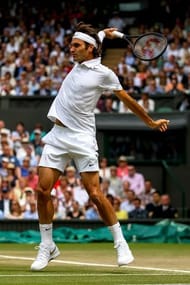Roger Federer seems to have been touched by the Gods. A maestro with a racket, he has every shot in the book. His game seems effortless and looks beautiful on the eye as he picks his opponents apart. The Swiss has a record 19 grand slam titles to his name, winning eight of them on grass.
In a tennis match, the surface on which the game is played is a critical factor in determining how a player adjusts. Grass is generally the fastest surface to play on. When the ball strikes a grass court, it bends the individual blades of grass, allowing bounce with very low friction. The ball loses very little speed and the exit angle is the lowest among the three surfaces. To compensate for the speed of grass, players must be able to react and move faster to reach the ball quickly.
Grass courts are not suited for a defensive style, and this is where Federer capitalises. The Swiss has a naturally aggressive style of play with his quick shots and sharp angles. Therefore, when he plays against opponents such as Rafael Nadal, Novak Djokovic and Andy Murray, he has a slight advantage, as they are challenged to defend the ball on such a quick surface
The bounce on clay and hard courts is much higher than on a grass court, and this affects Federer in a few different ways. Clay itself has a naturally high bounce and the acrylic on hard courts makes balls bounce even higher. If there is any weakness to Roger’s game, it is when high bouncing balls are played into his backhand. On grass, this rarely takes place.

On a grass surface, the ball skids off the surface. The lower bounce allows Roger to implement his backhand in an effective manner. Using his backhand, Federer can weave magic on a grass court where the bounce is quite low. He hits the lines with his majestic single-hander and even employs the slice, which is one of the best in the world today.
His single-handed backhand, although a relative liability on other surfaces, becomes a shot to contend with on grass at the baseline. He likes to keep the ball low with his slices and spins and forces his opponents to generate their own power. The slice and spin Roger puts on the ball often challenges players to play the ball from around their shins.
Most points on grass are short and crisp and this helps Federer greatly. The Swiss likes to get points over and done with without getting into long baseline rallies. The low bounce aids him in hitting his forehand with quite some topspin as the ball stays low and bends over the net.
Federer’s serve and forehand on grass give his game an edge. Grass courts reward a good serve, not just a big serve or a fast one. A well-placed serve could also be beneficial as it makes it tough for opponents to get the ball into play, and if they do, Federer is usually at the net with his forehand to end the point.
His serve is both powerful and accurate, but what makes it so effective is the variation he possesses. Federer has all the necessary weaponry, a wicked slice out wide, the kicker to an opponent’s backhand and the bomb down the "T". As well as having a great serve, Roger has a strong forehand. His serve is quite powerful, despite not being built like a John Isner or Ivo Karlovic.
Federer hits more corners and lines than any other top players, so even though he might not ace a player that often, he usually gets a weak reply which results in an easy forehand. Only Andy Roddick comes to mind, who during his peak, had an equally lethal serve and forehand combination.
Federer also has incredible footwork. He glides across the court and looks graceful while doing so, turning into a cheetah on the lawns of Wimbledon. Never one to be content with keeping the ball in play, Federer dictates play and comes up with elegant winners, more often than not.
Who Are Roger Federer's Kids? Know All About Federer's Twins
